Critical Review: Selected Research Articles from Psychological Science
VerifiedAdded on 2022/08/14
|11
|2717
|14
Literature Review
AI Summary
This assignment provides a detailed review and critique of four research articles from the field of psychological science. The first article explores the impact of sexual objectification on women's behavior in social interactions, focusing on how objectification can lead women to narrow their social presence. The second article examines the effects of media images on men's body and self-esteem, investigating the impact of idealized male images. The third article investigates the superior detection of threat-relevant stimuli in infancy, revealing that infants respond more rapidly to snakes and angry faces. Finally, the fourth article discusses source memory and eyewitness suggestibility in older adults, exploring memory distortion. Each review includes the study's purpose, methodology, results, and a critical evaluation of its strengths and weaknesses.
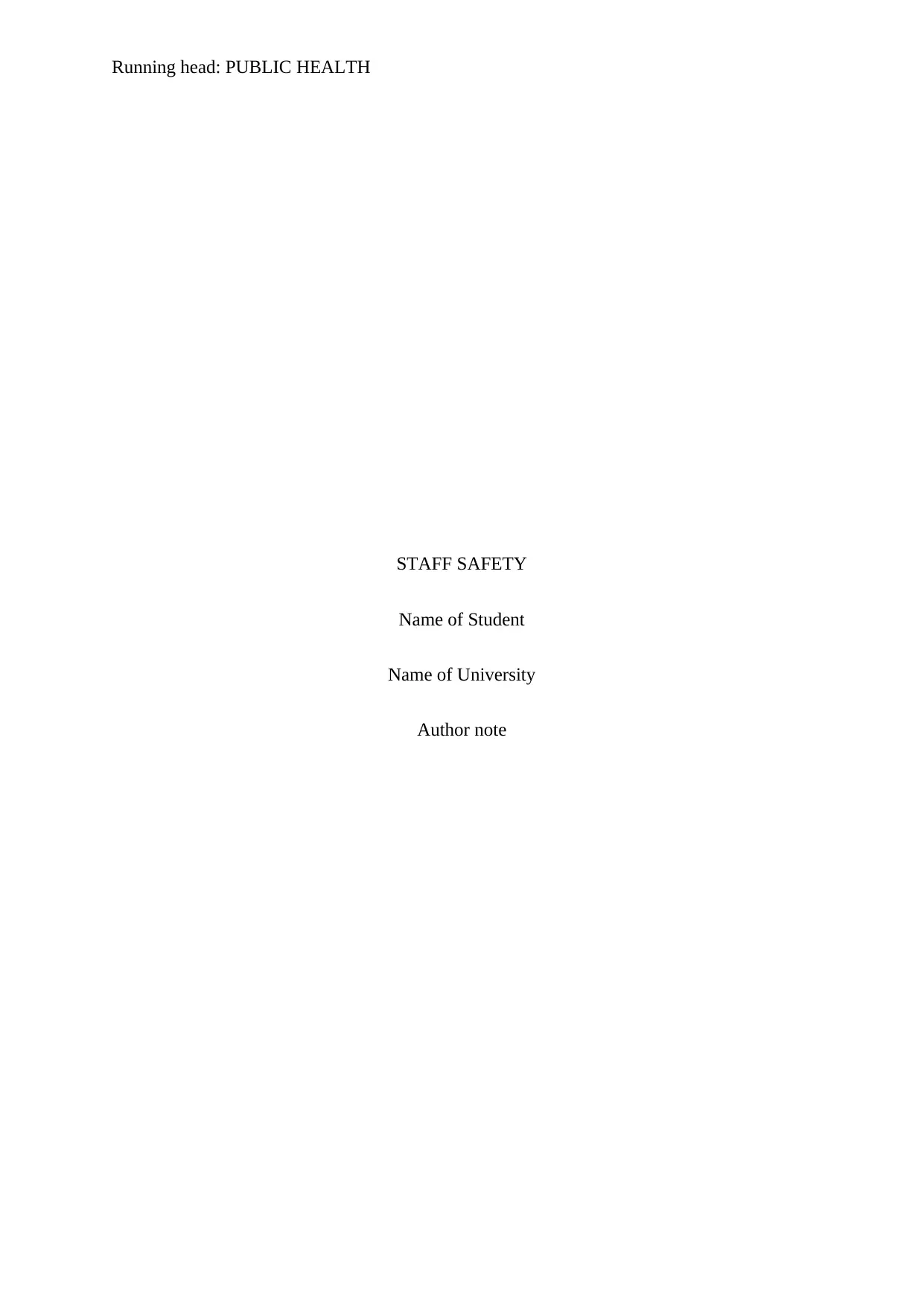
Running head: PUBLIC HEALTH
STAFF SAFETY
Name of Student
Name of University
Author note
STAFF SAFETY
Name of Student
Name of University
Author note
Paraphrase This Document
Need a fresh take? Get an instant paraphrase of this document with our AI Paraphraser
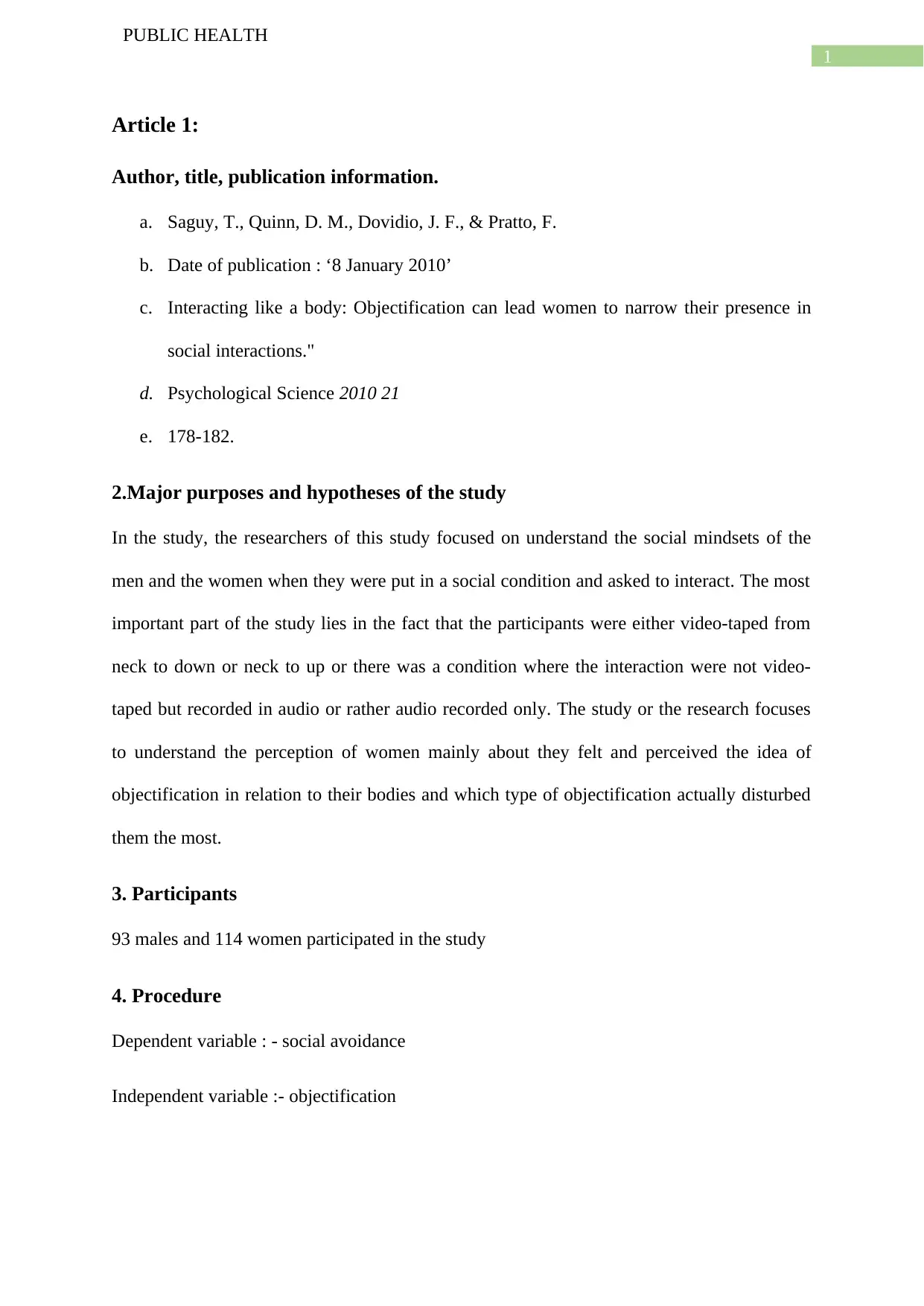
1
PUBLIC HEALTH
Article 1:
Author, title, publication information.
a. Saguy, T., Quinn, D. M., Dovidio, J. F., & Pratto, F.
b. Date of publication : ‘8 January 2010’
c. Interacting like a body: Objectification can lead women to narrow their presence in
social interactions."
d. Psychological Science 2010 21
e. 178-182.
2.Major purposes and hypotheses of the study
In the study, the researchers of this study focused on understand the social mindsets of the
men and the women when they were put in a social condition and asked to interact. The most
important part of the study lies in the fact that the participants were either video-taped from
neck to down or neck to up or there was a condition where the interaction were not video-
taped but recorded in audio or rather audio recorded only. The study or the research focuses
to understand the perception of women mainly about they felt and perceived the idea of
objectification in relation to their bodies and which type of objectification actually disturbed
them the most.
3. Participants
93 males and 114 women participated in the study
4. Procedure
Dependent variable : - social avoidance
Independent variable :- objectification
PUBLIC HEALTH
Article 1:
Author, title, publication information.
a. Saguy, T., Quinn, D. M., Dovidio, J. F., & Pratto, F.
b. Date of publication : ‘8 January 2010’
c. Interacting like a body: Objectification can lead women to narrow their presence in
social interactions."
d. Psychological Science 2010 21
e. 178-182.
2.Major purposes and hypotheses of the study
In the study, the researchers of this study focused on understand the social mindsets of the
men and the women when they were put in a social condition and asked to interact. The most
important part of the study lies in the fact that the participants were either video-taped from
neck to down or neck to up or there was a condition where the interaction were not video-
taped but recorded in audio or rather audio recorded only. The study or the research focuses
to understand the perception of women mainly about they felt and perceived the idea of
objectification in relation to their bodies and which type of objectification actually disturbed
them the most.
3. Participants
93 males and 114 women participated in the study
4. Procedure
Dependent variable : - social avoidance
Independent variable :- objectification
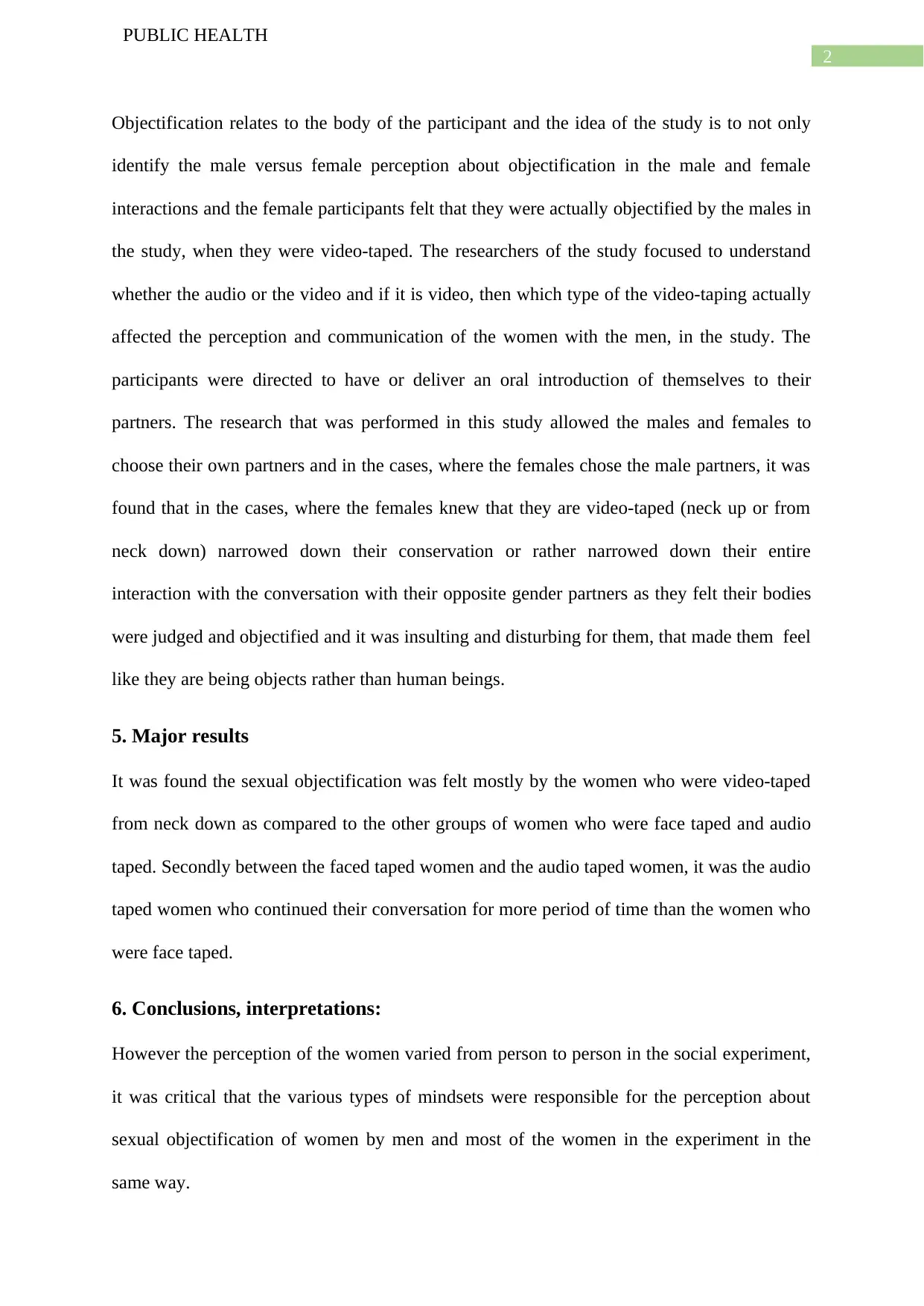
2
PUBLIC HEALTH
Objectification relates to the body of the participant and the idea of the study is to not only
identify the male versus female perception about objectification in the male and female
interactions and the female participants felt that they were actually objectified by the males in
the study, when they were video-taped. The researchers of the study focused to understand
whether the audio or the video and if it is video, then which type of the video-taping actually
affected the perception and communication of the women with the men, in the study. The
participants were directed to have or deliver an oral introduction of themselves to their
partners. The research that was performed in this study allowed the males and females to
choose their own partners and in the cases, where the females chose the male partners, it was
found that in the cases, where the females knew that they are video-taped (neck up or from
neck down) narrowed down their conservation or rather narrowed down their entire
interaction with the conversation with their opposite gender partners as they felt their bodies
were judged and objectified and it was insulting and disturbing for them, that made them feel
like they are being objects rather than human beings.
5. Major results
It was found the sexual objectification was felt mostly by the women who were video-taped
from neck down as compared to the other groups of women who were face taped and audio
taped. Secondly between the faced taped women and the audio taped women, it was the audio
taped women who continued their conversation for more period of time than the women who
were face taped.
6. Conclusions, interpretations:
However the perception of the women varied from person to person in the social experiment,
it was critical that the various types of mindsets were responsible for the perception about
sexual objectification of women by men and most of the women in the experiment in the
same way.
PUBLIC HEALTH
Objectification relates to the body of the participant and the idea of the study is to not only
identify the male versus female perception about objectification in the male and female
interactions and the female participants felt that they were actually objectified by the males in
the study, when they were video-taped. The researchers of the study focused to understand
whether the audio or the video and if it is video, then which type of the video-taping actually
affected the perception and communication of the women with the men, in the study. The
participants were directed to have or deliver an oral introduction of themselves to their
partners. The research that was performed in this study allowed the males and females to
choose their own partners and in the cases, where the females chose the male partners, it was
found that in the cases, where the females knew that they are video-taped (neck up or from
neck down) narrowed down their conservation or rather narrowed down their entire
interaction with the conversation with their opposite gender partners as they felt their bodies
were judged and objectified and it was insulting and disturbing for them, that made them feel
like they are being objects rather than human beings.
5. Major results
It was found the sexual objectification was felt mostly by the women who were video-taped
from neck down as compared to the other groups of women who were face taped and audio
taped. Secondly between the faced taped women and the audio taped women, it was the audio
taped women who continued their conversation for more period of time than the women who
were face taped.
6. Conclusions, interpretations:
However the perception of the women varied from person to person in the social experiment,
it was critical that the various types of mindsets were responsible for the perception about
sexual objectification of women by men and most of the women in the experiment in the
same way.
⊘ This is a preview!⊘
Do you want full access?
Subscribe today to unlock all pages.

Trusted by 1+ million students worldwide
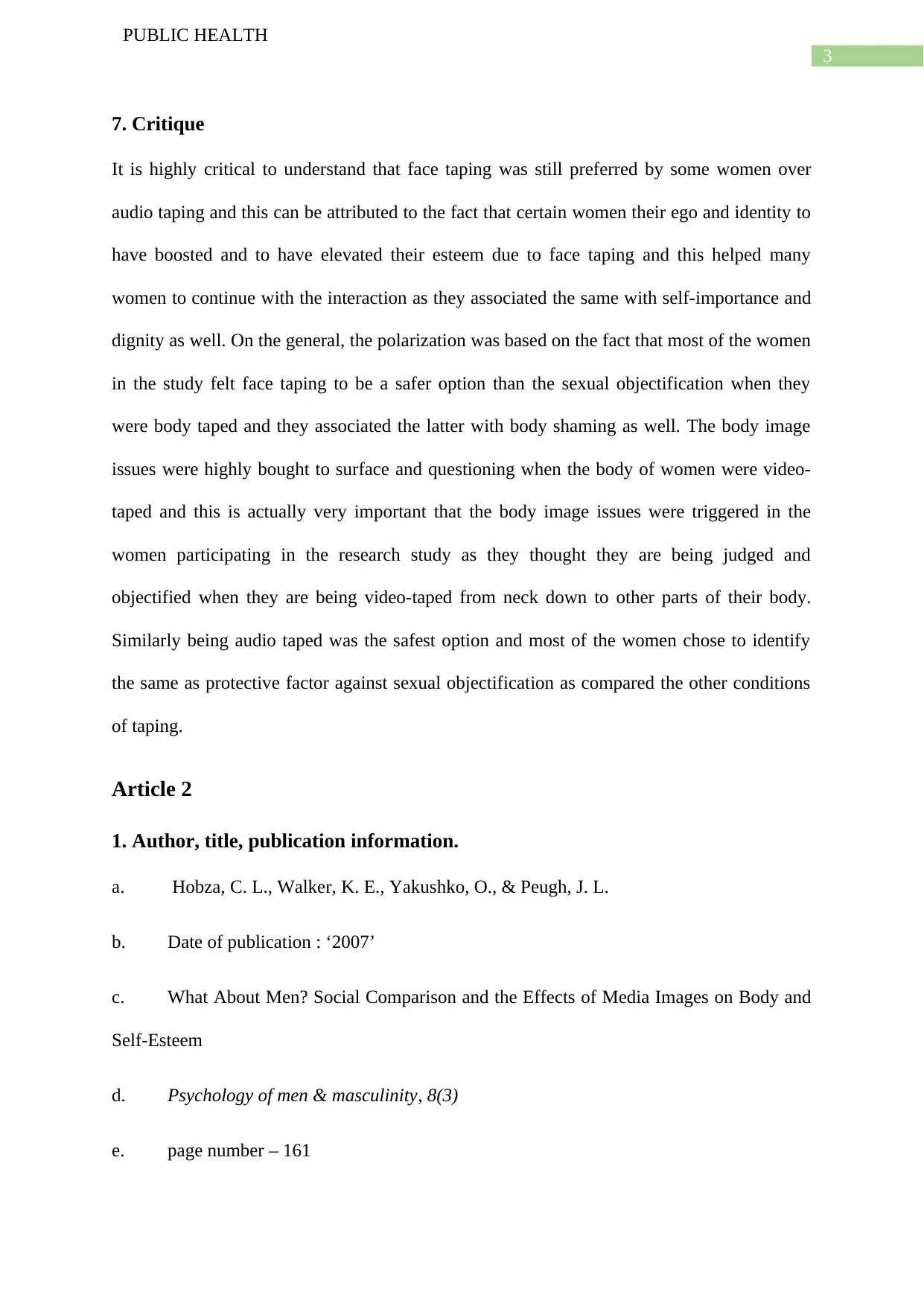
3
PUBLIC HEALTH
7. Critique
It is highly critical to understand that face taping was still preferred by some women over
audio taping and this can be attributed to the fact that certain women their ego and identity to
have boosted and to have elevated their esteem due to face taping and this helped many
women to continue with the interaction as they associated the same with self-importance and
dignity as well. On the general, the polarization was based on the fact that most of the women
in the study felt face taping to be a safer option than the sexual objectification when they
were body taped and they associated the latter with body shaming as well. The body image
issues were highly bought to surface and questioning when the body of women were video-
taped and this is actually very important that the body image issues were triggered in the
women participating in the research study as they thought they are being judged and
objectified when they are being video-taped from neck down to other parts of their body.
Similarly being audio taped was the safest option and most of the women chose to identify
the same as protective factor against sexual objectification as compared the other conditions
of taping.
Article 2
1. Author, title, publication information.
a. Hobza, C. L., Walker, K. E., Yakushko, O., & Peugh, J. L.
b. Date of publication : ‘2007’
c. What About Men? Social Comparison and the Effects of Media Images on Body and
Self-Esteem
d. Psychology of men & masculinity, 8(3)
e. page number – 161
PUBLIC HEALTH
7. Critique
It is highly critical to understand that face taping was still preferred by some women over
audio taping and this can be attributed to the fact that certain women their ego and identity to
have boosted and to have elevated their esteem due to face taping and this helped many
women to continue with the interaction as they associated the same with self-importance and
dignity as well. On the general, the polarization was based on the fact that most of the women
in the study felt face taping to be a safer option than the sexual objectification when they
were body taped and they associated the latter with body shaming as well. The body image
issues were highly bought to surface and questioning when the body of women were video-
taped and this is actually very important that the body image issues were triggered in the
women participating in the research study as they thought they are being judged and
objectified when they are being video-taped from neck down to other parts of their body.
Similarly being audio taped was the safest option and most of the women chose to identify
the same as protective factor against sexual objectification as compared the other conditions
of taping.
Article 2
1. Author, title, publication information.
a. Hobza, C. L., Walker, K. E., Yakushko, O., & Peugh, J. L.
b. Date of publication : ‘2007’
c. What About Men? Social Comparison and the Effects of Media Images on Body and
Self-Esteem
d. Psychology of men & masculinity, 8(3)
e. page number – 161
Paraphrase This Document
Need a fresh take? Get an instant paraphrase of this document with our AI Paraphraser
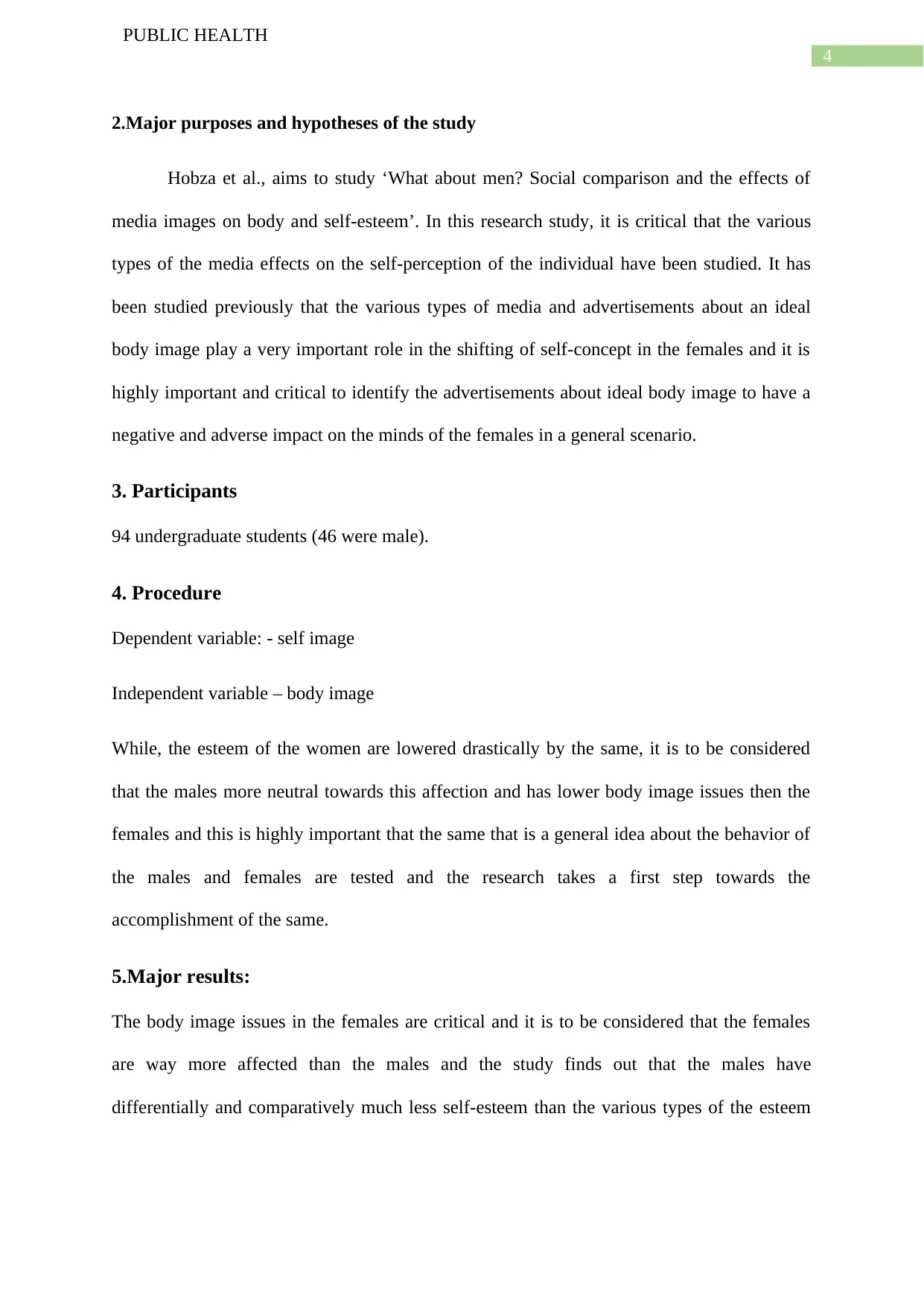
4
PUBLIC HEALTH
2.Major purposes and hypotheses of the study
Hobza et al., aims to study ‘What about men? Social comparison and the effects of
media images on body and self-esteem’. In this research study, it is critical that the various
types of the media effects on the self-perception of the individual have been studied. It has
been studied previously that the various types of media and advertisements about an ideal
body image play a very important role in the shifting of self-concept in the females and it is
highly important and critical to identify the advertisements about ideal body image to have a
negative and adverse impact on the minds of the females in a general scenario.
3. Participants
94 undergraduate students (46 were male).
4. Procedure
Dependent variable: - self image
Independent variable – body image
While, the esteem of the women are lowered drastically by the same, it is to be considered
that the males more neutral towards this affection and has lower body image issues then the
females and this is highly important that the same that is a general idea about the behavior of
the males and females are tested and the research takes a first step towards the
accomplishment of the same.
5.Major results:
The body image issues in the females are critical and it is to be considered that the females
are way more affected than the males and the study finds out that the males have
differentially and comparatively much less self-esteem than the various types of the esteem
PUBLIC HEALTH
2.Major purposes and hypotheses of the study
Hobza et al., aims to study ‘What about men? Social comparison and the effects of
media images on body and self-esteem’. In this research study, it is critical that the various
types of the media effects on the self-perception of the individual have been studied. It has
been studied previously that the various types of media and advertisements about an ideal
body image play a very important role in the shifting of self-concept in the females and it is
highly important and critical to identify the advertisements about ideal body image to have a
negative and adverse impact on the minds of the females in a general scenario.
3. Participants
94 undergraduate students (46 were male).
4. Procedure
Dependent variable: - self image
Independent variable – body image
While, the esteem of the women are lowered drastically by the same, it is to be considered
that the males more neutral towards this affection and has lower body image issues then the
females and this is highly important that the same that is a general idea about the behavior of
the males and females are tested and the research takes a first step towards the
accomplishment of the same.
5.Major results:
The body image issues in the females are critical and it is to be considered that the females
are way more affected than the males and the study finds out that the males have
differentially and comparatively much less self-esteem than the various types of the esteem
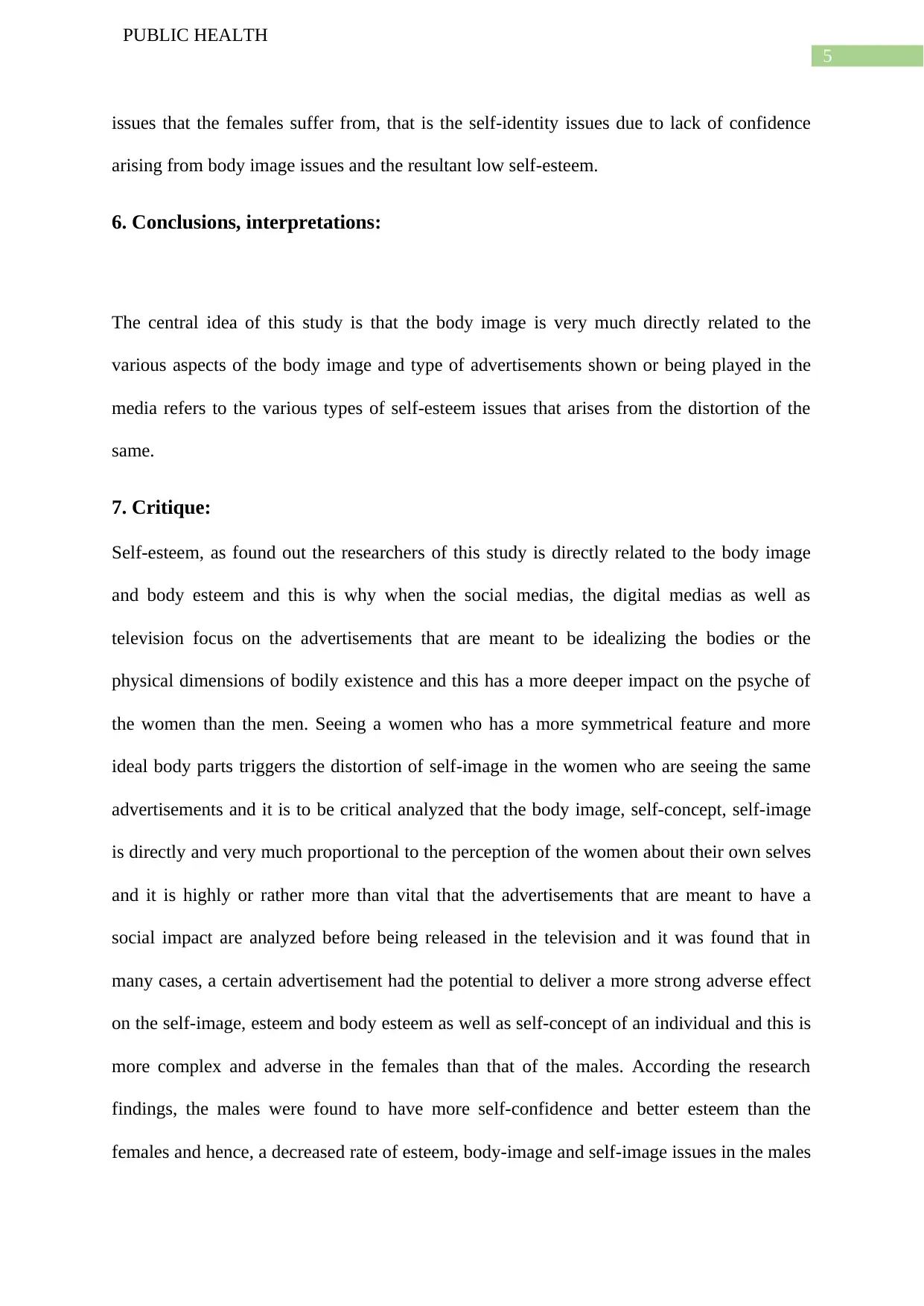
5
PUBLIC HEALTH
issues that the females suffer from, that is the self-identity issues due to lack of confidence
arising from body image issues and the resultant low self-esteem.
6. Conclusions, interpretations:
The central idea of this study is that the body image is very much directly related to the
various aspects of the body image and type of advertisements shown or being played in the
media refers to the various types of self-esteem issues that arises from the distortion of the
same.
7. Critique:
Self-esteem, as found out the researchers of this study is directly related to the body image
and body esteem and this is why when the social medias, the digital medias as well as
television focus on the advertisements that are meant to be idealizing the bodies or the
physical dimensions of bodily existence and this has a more deeper impact on the psyche of
the women than the men. Seeing a women who has a more symmetrical feature and more
ideal body parts triggers the distortion of self-image in the women who are seeing the same
advertisements and it is to be critical analyzed that the body image, self-concept, self-image
is directly and very much proportional to the perception of the women about their own selves
and it is highly or rather more than vital that the advertisements that are meant to have a
social impact are analyzed before being released in the television and it was found that in
many cases, a certain advertisement had the potential to deliver a more strong adverse effect
on the self-image, esteem and body esteem as well as self-concept of an individual and this is
more complex and adverse in the females than that of the males. According the research
findings, the males were found to have more self-confidence and better esteem than the
females and hence, a decreased rate of esteem, body-image and self-image issues in the males
PUBLIC HEALTH
issues that the females suffer from, that is the self-identity issues due to lack of confidence
arising from body image issues and the resultant low self-esteem.
6. Conclusions, interpretations:
The central idea of this study is that the body image is very much directly related to the
various aspects of the body image and type of advertisements shown or being played in the
media refers to the various types of self-esteem issues that arises from the distortion of the
same.
7. Critique:
Self-esteem, as found out the researchers of this study is directly related to the body image
and body esteem and this is why when the social medias, the digital medias as well as
television focus on the advertisements that are meant to be idealizing the bodies or the
physical dimensions of bodily existence and this has a more deeper impact on the psyche of
the women than the men. Seeing a women who has a more symmetrical feature and more
ideal body parts triggers the distortion of self-image in the women who are seeing the same
advertisements and it is to be critical analyzed that the body image, self-concept, self-image
is directly and very much proportional to the perception of the women about their own selves
and it is highly or rather more than vital that the advertisements that are meant to have a
social impact are analyzed before being released in the television and it was found that in
many cases, a certain advertisement had the potential to deliver a more strong adverse effect
on the self-image, esteem and body esteem as well as self-concept of an individual and this is
more complex and adverse in the females than that of the males. According the research
findings, the males were found to have more self-confidence and better esteem than the
females and hence, a decreased rate of esteem, body-image and self-image issues in the males
⊘ This is a preview!⊘
Do you want full access?
Subscribe today to unlock all pages.

Trusted by 1+ million students worldwide
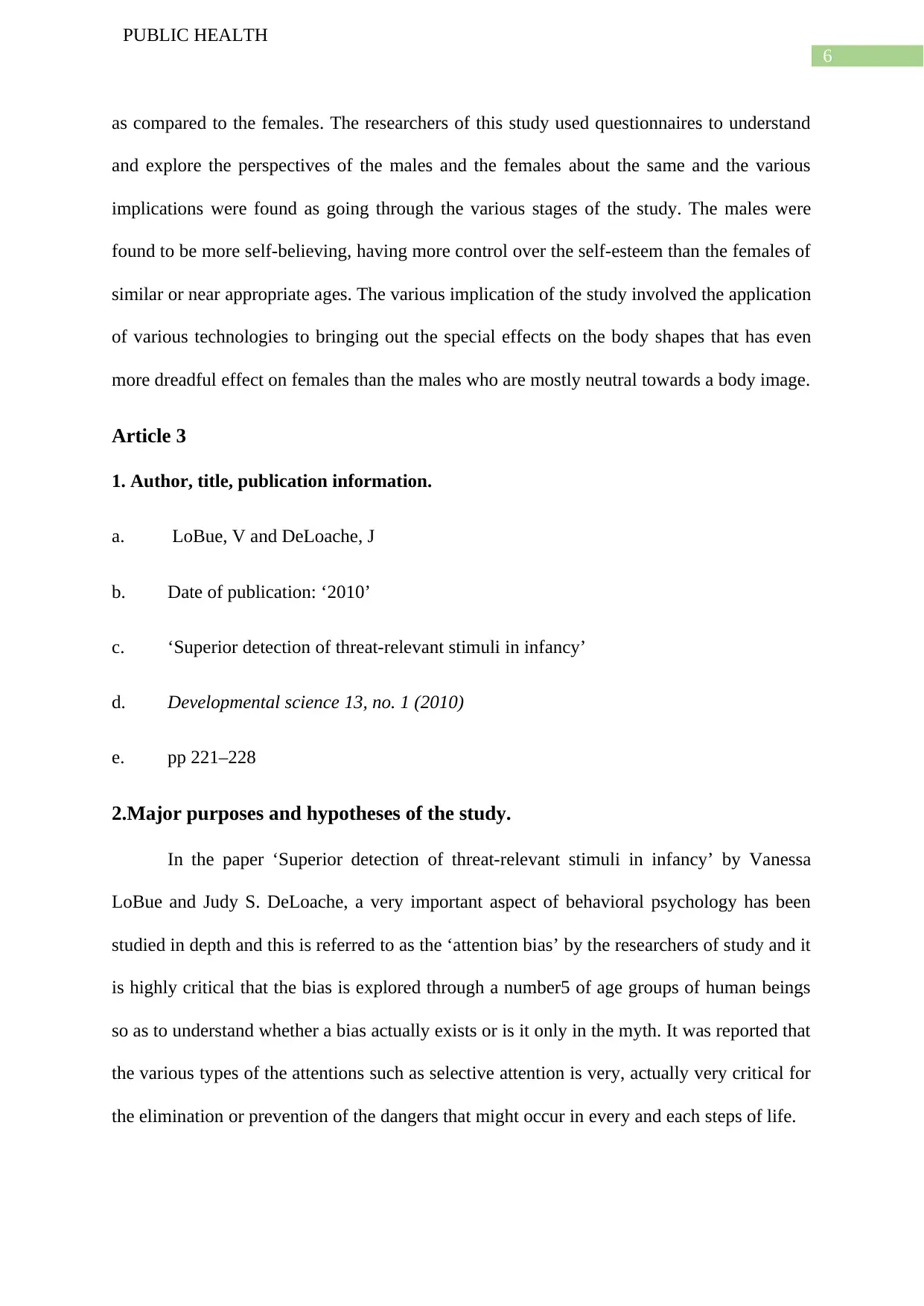
6
PUBLIC HEALTH
as compared to the females. The researchers of this study used questionnaires to understand
and explore the perspectives of the males and the females about the same and the various
implications were found as going through the various stages of the study. The males were
found to be more self-believing, having more control over the self-esteem than the females of
similar or near appropriate ages. The various implication of the study involved the application
of various technologies to bringing out the special effects on the body shapes that has even
more dreadful effect on females than the males who are mostly neutral towards a body image.
Article 3
1. Author, title, publication information.
a. LoBue, V and DeLoache, J
b. Date of publication: ‘2010’
c. ‘Superior detection of threat-relevant stimuli in infancy’
d. Developmental science 13, no. 1 (2010)
e. pp 221–228
2.Major purposes and hypotheses of the study.
In the paper ‘Superior detection of threat-relevant stimuli in infancy’ by Vanessa
LoBue and Judy S. DeLoache, a very important aspect of behavioral psychology has been
studied in depth and this is referred to as the ‘attention bias’ by the researchers of study and it
is highly critical that the bias is explored through a number5 of age groups of human beings
so as to understand whether a bias actually exists or is it only in the myth. It was reported that
the various types of the attentions such as selective attention is very, actually very critical for
the elimination or prevention of the dangers that might occur in every and each steps of life.
PUBLIC HEALTH
as compared to the females. The researchers of this study used questionnaires to understand
and explore the perspectives of the males and the females about the same and the various
implications were found as going through the various stages of the study. The males were
found to be more self-believing, having more control over the self-esteem than the females of
similar or near appropriate ages. The various implication of the study involved the application
of various technologies to bringing out the special effects on the body shapes that has even
more dreadful effect on females than the males who are mostly neutral towards a body image.
Article 3
1. Author, title, publication information.
a. LoBue, V and DeLoache, J
b. Date of publication: ‘2010’
c. ‘Superior detection of threat-relevant stimuli in infancy’
d. Developmental science 13, no. 1 (2010)
e. pp 221–228
2.Major purposes and hypotheses of the study.
In the paper ‘Superior detection of threat-relevant stimuli in infancy’ by Vanessa
LoBue and Judy S. DeLoache, a very important aspect of behavioral psychology has been
studied in depth and this is referred to as the ‘attention bias’ by the researchers of study and it
is highly critical that the bias is explored through a number5 of age groups of human beings
so as to understand whether a bias actually exists or is it only in the myth. It was reported that
the various types of the attentions such as selective attention is very, actually very critical for
the elimination or prevention of the dangers that might occur in every and each steps of life.
Paraphrase This Document
Need a fresh take? Get an instant paraphrase of this document with our AI Paraphraser
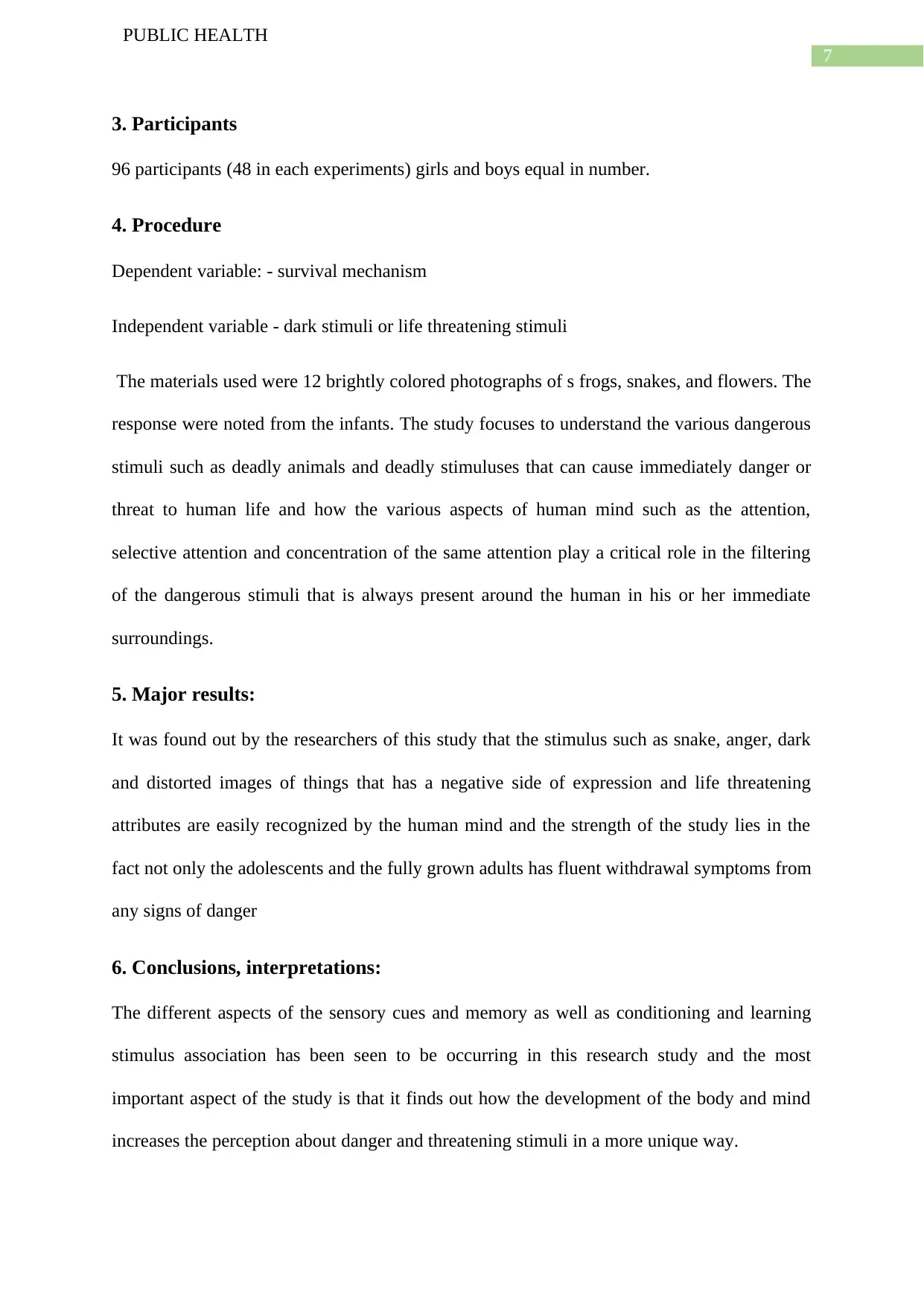
7
PUBLIC HEALTH
3. Participants
96 participants (48 in each experiments) girls and boys equal in number.
4. Procedure
Dependent variable: - survival mechanism
Independent variable - dark stimuli or life threatening stimuli
The materials used were 12 brightly colored photographs of s frogs, snakes, and flowers. The
response were noted from the infants. The study focuses to understand the various dangerous
stimuli such as deadly animals and deadly stimuluses that can cause immediately danger or
threat to human life and how the various aspects of human mind such as the attention,
selective attention and concentration of the same attention play a critical role in the filtering
of the dangerous stimuli that is always present around the human in his or her immediate
surroundings.
5. Major results:
It was found out by the researchers of this study that the stimulus such as snake, anger, dark
and distorted images of things that has a negative side of expression and life threatening
attributes are easily recognized by the human mind and the strength of the study lies in the
fact not only the adolescents and the fully grown adults has fluent withdrawal symptoms from
any signs of danger
6. Conclusions, interpretations:
The different aspects of the sensory cues and memory as well as conditioning and learning
stimulus association has been seen to be occurring in this research study and the most
important aspect of the study is that it finds out how the development of the body and mind
increases the perception about danger and threatening stimuli in a more unique way.
PUBLIC HEALTH
3. Participants
96 participants (48 in each experiments) girls and boys equal in number.
4. Procedure
Dependent variable: - survival mechanism
Independent variable - dark stimuli or life threatening stimuli
The materials used were 12 brightly colored photographs of s frogs, snakes, and flowers. The
response were noted from the infants. The study focuses to understand the various dangerous
stimuli such as deadly animals and deadly stimuluses that can cause immediately danger or
threat to human life and how the various aspects of human mind such as the attention,
selective attention and concentration of the same attention play a critical role in the filtering
of the dangerous stimuli that is always present around the human in his or her immediate
surroundings.
5. Major results:
It was found out by the researchers of this study that the stimulus such as snake, anger, dark
and distorted images of things that has a negative side of expression and life threatening
attributes are easily recognized by the human mind and the strength of the study lies in the
fact not only the adolescents and the fully grown adults has fluent withdrawal symptoms from
any signs of danger
6. Conclusions, interpretations:
The different aspects of the sensory cues and memory as well as conditioning and learning
stimulus association has been seen to be occurring in this research study and the most
important aspect of the study is that it finds out how the development of the body and mind
increases the perception about danger and threatening stimuli in a more unique way.
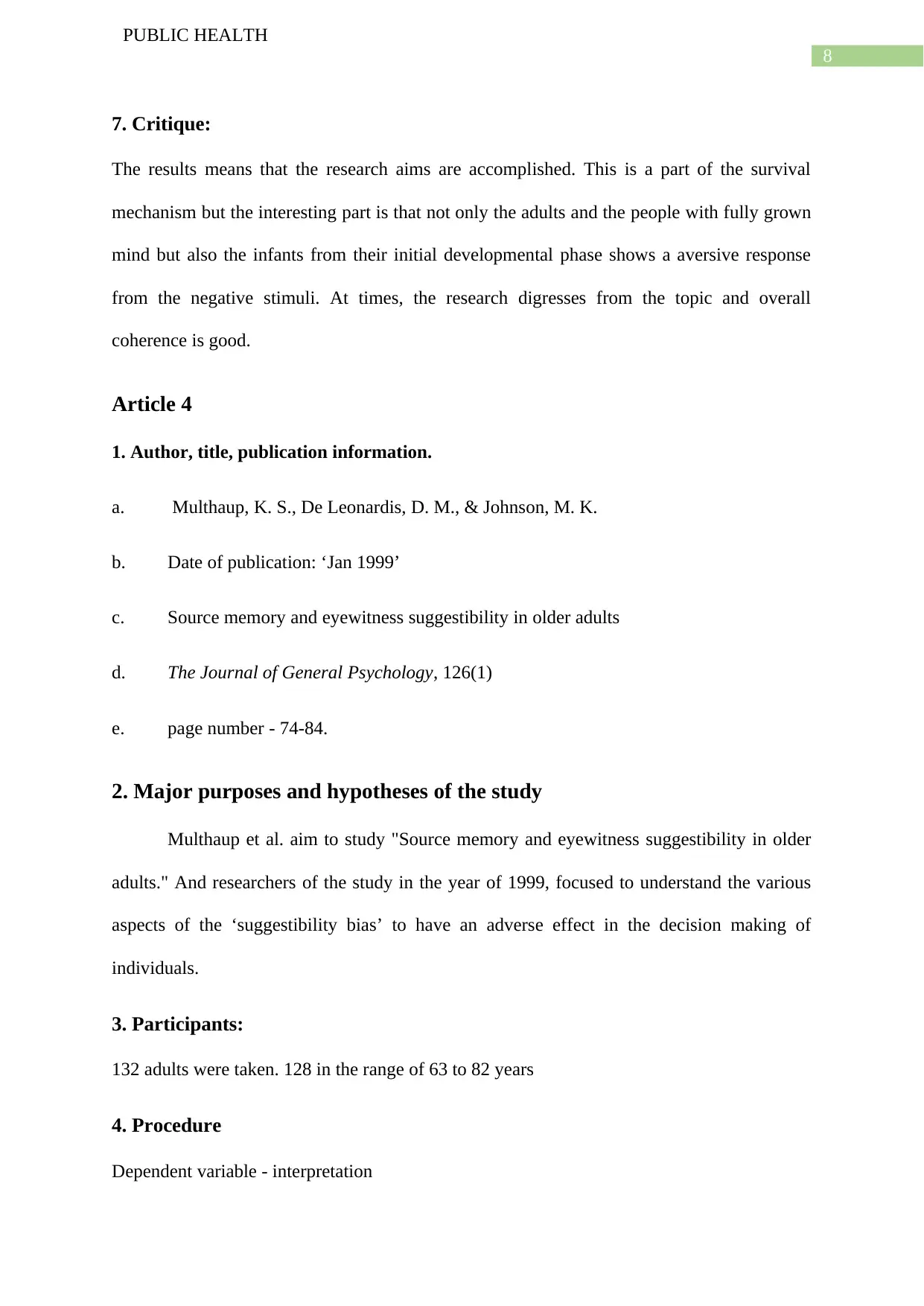
8
PUBLIC HEALTH
7. Critique:
The results means that the research aims are accomplished. This is a part of the survival
mechanism but the interesting part is that not only the adults and the people with fully grown
mind but also the infants from their initial developmental phase shows a aversive response
from the negative stimuli. At times, the research digresses from the topic and overall
coherence is good.
Article 4
1. Author, title, publication information.
a. Multhaup, K. S., De Leonardis, D. M., & Johnson, M. K.
b. Date of publication: ‘Jan 1999’
c. Source memory and eyewitness suggestibility in older adults
d. The Journal of General Psychology, 126(1)
e. page number - 74-84.
2. Major purposes and hypotheses of the study
Multhaup et al. aim to study "Source memory and eyewitness suggestibility in older
adults." And researchers of the study in the year of 1999, focused to understand the various
aspects of the ‘suggestibility bias’ to have an adverse effect in the decision making of
individuals.
3. Participants:
132 adults were taken. 128 in the range of 63 to 82 years
4. Procedure
Dependent variable - interpretation
PUBLIC HEALTH
7. Critique:
The results means that the research aims are accomplished. This is a part of the survival
mechanism but the interesting part is that not only the adults and the people with fully grown
mind but also the infants from their initial developmental phase shows a aversive response
from the negative stimuli. At times, the research digresses from the topic and overall
coherence is good.
Article 4
1. Author, title, publication information.
a. Multhaup, K. S., De Leonardis, D. M., & Johnson, M. K.
b. Date of publication: ‘Jan 1999’
c. Source memory and eyewitness suggestibility in older adults
d. The Journal of General Psychology, 126(1)
e. page number - 74-84.
2. Major purposes and hypotheses of the study
Multhaup et al. aim to study "Source memory and eyewitness suggestibility in older
adults." And researchers of the study in the year of 1999, focused to understand the various
aspects of the ‘suggestibility bias’ to have an adverse effect in the decision making of
individuals.
3. Participants:
132 adults were taken. 128 in the range of 63 to 82 years
4. Procedure
Dependent variable - interpretation
⊘ This is a preview!⊘
Do you want full access?
Subscribe today to unlock all pages.

Trusted by 1+ million students worldwide
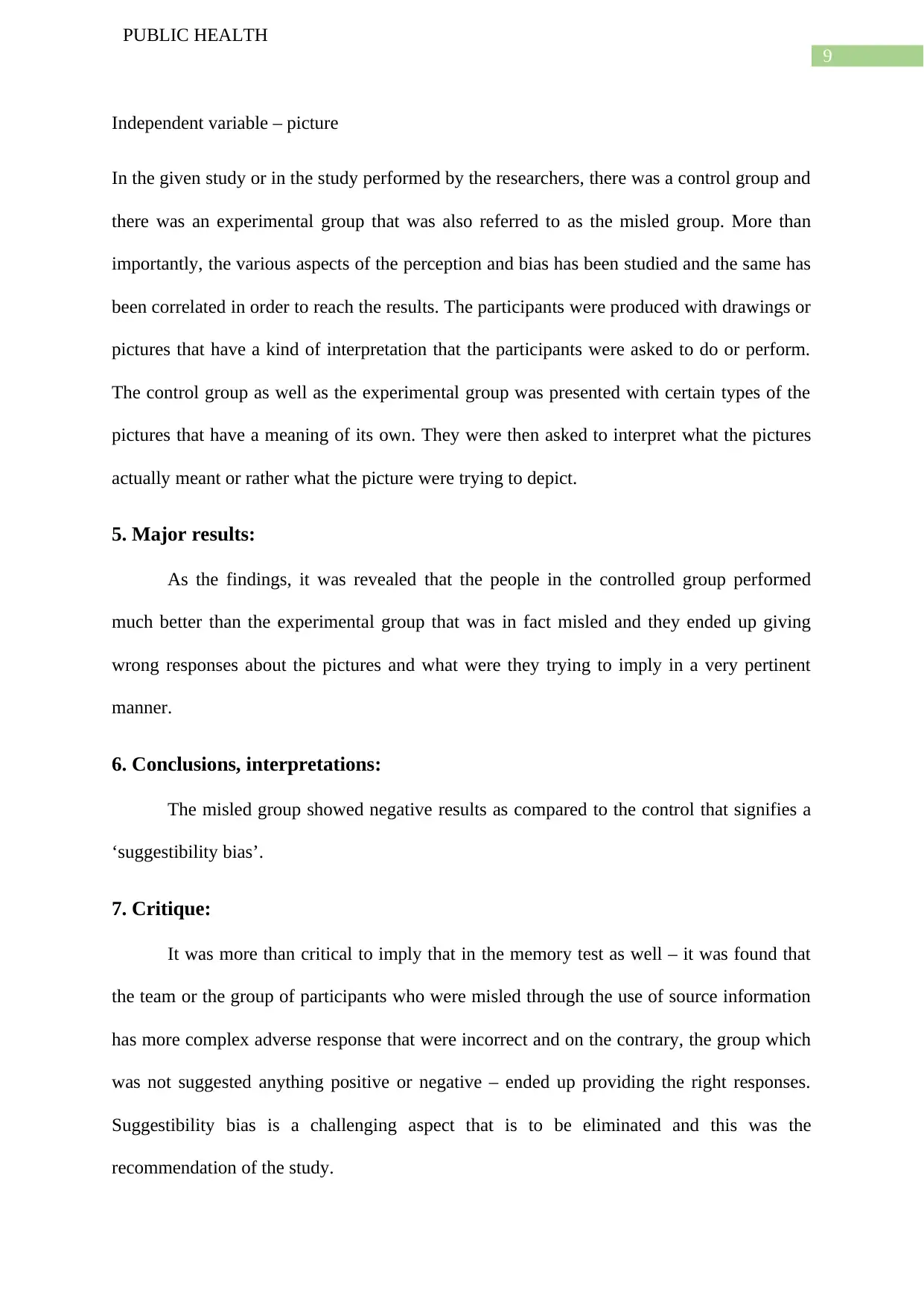
9
PUBLIC HEALTH
Independent variable – picture
In the given study or in the study performed by the researchers, there was a control group and
there was an experimental group that was also referred to as the misled group. More than
importantly, the various aspects of the perception and bias has been studied and the same has
been correlated in order to reach the results. The participants were produced with drawings or
pictures that have a kind of interpretation that the participants were asked to do or perform.
The control group as well as the experimental group was presented with certain types of the
pictures that have a meaning of its own. They were then asked to interpret what the pictures
actually meant or rather what the picture were trying to depict.
5. Major results:
As the findings, it was revealed that the people in the controlled group performed
much better than the experimental group that was in fact misled and they ended up giving
wrong responses about the pictures and what were they trying to imply in a very pertinent
manner.
6. Conclusions, interpretations:
The misled group showed negative results as compared to the control that signifies a
‘suggestibility bias’.
7. Critique:
It was more than critical to imply that in the memory test as well – it was found that
the team or the group of participants who were misled through the use of source information
has more complex adverse response that were incorrect and on the contrary, the group which
was not suggested anything positive or negative – ended up providing the right responses.
Suggestibility bias is a challenging aspect that is to be eliminated and this was the
recommendation of the study.
PUBLIC HEALTH
Independent variable – picture
In the given study or in the study performed by the researchers, there was a control group and
there was an experimental group that was also referred to as the misled group. More than
importantly, the various aspects of the perception and bias has been studied and the same has
been correlated in order to reach the results. The participants were produced with drawings or
pictures that have a kind of interpretation that the participants were asked to do or perform.
The control group as well as the experimental group was presented with certain types of the
pictures that have a meaning of its own. They were then asked to interpret what the pictures
actually meant or rather what the picture were trying to depict.
5. Major results:
As the findings, it was revealed that the people in the controlled group performed
much better than the experimental group that was in fact misled and they ended up giving
wrong responses about the pictures and what were they trying to imply in a very pertinent
manner.
6. Conclusions, interpretations:
The misled group showed negative results as compared to the control that signifies a
‘suggestibility bias’.
7. Critique:
It was more than critical to imply that in the memory test as well – it was found that
the team or the group of participants who were misled through the use of source information
has more complex adverse response that were incorrect and on the contrary, the group which
was not suggested anything positive or negative – ended up providing the right responses.
Suggestibility bias is a challenging aspect that is to be eliminated and this was the
recommendation of the study.
Paraphrase This Document
Need a fresh take? Get an instant paraphrase of this document with our AI Paraphraser
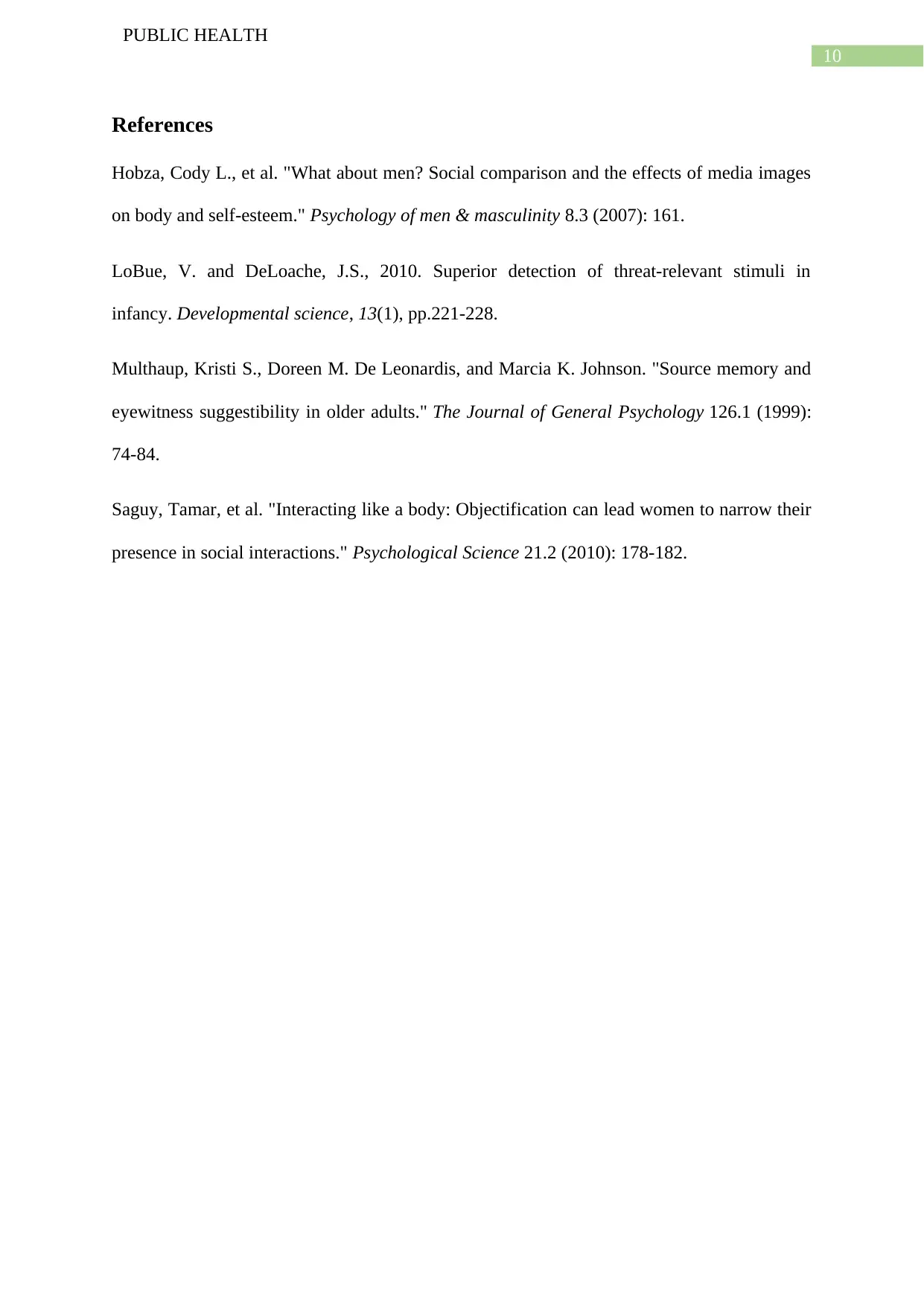
10
PUBLIC HEALTH
References
Hobza, Cody L., et al. "What about men? Social comparison and the effects of media images
on body and self-esteem." Psychology of men & masculinity 8.3 (2007): 161.
LoBue, V. and DeLoache, J.S., 2010. Superior detection of threat‐relevant stimuli in
infancy. Developmental science, 13(1), pp.221-228.
Multhaup, Kristi S., Doreen M. De Leonardis, and Marcia K. Johnson. "Source memory and
eyewitness suggestibility in older adults." The Journal of General Psychology 126.1 (1999):
74-84.
Saguy, Tamar, et al. "Interacting like a body: Objectification can lead women to narrow their
presence in social interactions." Psychological Science 21.2 (2010): 178-182.
PUBLIC HEALTH
References
Hobza, Cody L., et al. "What about men? Social comparison and the effects of media images
on body and self-esteem." Psychology of men & masculinity 8.3 (2007): 161.
LoBue, V. and DeLoache, J.S., 2010. Superior detection of threat‐relevant stimuli in
infancy. Developmental science, 13(1), pp.221-228.
Multhaup, Kristi S., Doreen M. De Leonardis, and Marcia K. Johnson. "Source memory and
eyewitness suggestibility in older adults." The Journal of General Psychology 126.1 (1999):
74-84.
Saguy, Tamar, et al. "Interacting like a body: Objectification can lead women to narrow their
presence in social interactions." Psychological Science 21.2 (2010): 178-182.
1 out of 11
Your All-in-One AI-Powered Toolkit for Academic Success.
+13062052269
info@desklib.com
Available 24*7 on WhatsApp / Email
![[object Object]](/_next/static/media/star-bottom.7253800d.svg)
Unlock your academic potential
Copyright © 2020–2025 A2Z Services. All Rights Reserved. Developed and managed by ZUCOL.